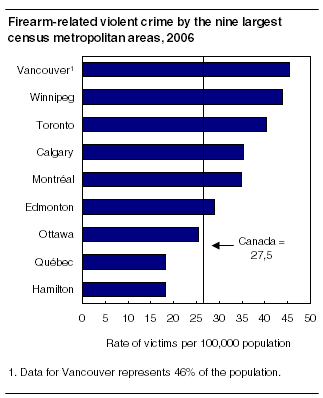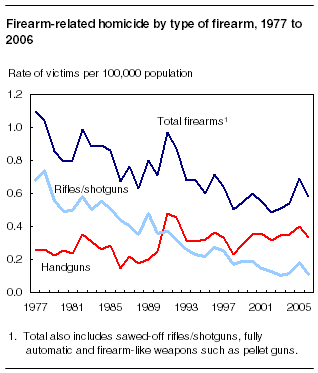Common menu bar links
Study: Firearms and violent crime
Archived Content
Information identified as archived is provided for reference, research or recordkeeping purposes. It is not subject to the Government of Canada Web Standards and has not been altered or updated since it was archived. Please "contact us" to request a format other than those available.

The 2006 rate of violent crime involving the use of firearms in Canada remained stable for the fourth consecutive year, according to a new study examining trends in gun violence.
Canadian police services reported just over 8,100 victims of violent gun crime, ranging from assault to robbery and homicide, accounting for 2.4% of all victims of violence. Handguns made up nearly two-thirds of all firearms used.
Violent crimes were more often committed with other types of weapons than guns. Knives accounted for 6.2% of violent victimizations and clubs or other blunt instruments were used against 3.0% of victims.
Police-reported data showed that among young people, the use of guns in violent crime is increasing. The rate of youth aged 12 to 17 accused of a firearm-related offence has risen in three of the past four years, increasing 32% since 2002. The overall firearm-related crime rates for youth were driven primarily by robberies.
In 2006, 1,287 young people were accused of a violent offence in which a gun was used. They accounted for 2.8% of all youth accused of violence; in contrast, 1.8% of adults accused of a violent offence had used a firearm.
Generally, the highest rates of gun violence in 2006 were found in Canada's largest cities. Vancouver had the highest rate among all census metropolitan areas (CMAs), followed by Winnipeg and Toronto. Among youth, however, the rates of violence involving firearms were highest in Toronto and Saskatoon.
About three-quarters of the total number of violent victimizations involving guns in 2006 were robbery and assault. Although the incidence of attempted murder and homicide was much lower, about one-third of these offences were committed with a firearm.
Adults convicted of a violent gun crime were sentenced, on average, to just over four years in prison, double the typical sentence length of those convicted of the same violent offence where a firearm had not been used.
One-quarter of firearm-related victimizations occur in Toronto
A total of 1,993 people in the Toronto CMA were victims of a violent offence related to guns in 2006, about one-quarter of the national total.
However, in terms of rates which take into account differences in population, Toronto was third highest behind Vancouver and Winnipeg.
In Vancouver, there were 45.3 violent offences involving guns for every 100,000 population, the highest rate in the nation and well above the national average of 27.5. Winnipeg's rate was 43.9 and Toronto's was 40.4.

Edmonton reported the highest rate of homicide related to guns in 2006, followed by Abbotsford, where the rate was highest during the previous four years.
Note to readersThis Juristat uses data from Statistic Canada's Uniform Crime Reporting and Homicide Surveys to examine the prevalence of firearm-related violent crime in Canada at the national, provincial and census metropolitan area levels. It presents the incidence and trends in overall firearm violence and the characteristics of those offences most often committed with a firearm. It also compares Canada's firearm-related homicide rate with those of other countries. Data from the Integrated Criminal Courts Survey are used to compare court processing and sentencing outcomes between firearm and non-firearm violent offences. |
For the third year in a row, Halifax reported the highest rate of robbery involving firearms. Its rate was nearly double those in Vancouver and Toronto, the next highest cities.
Provincially, firearm-related violence was higher in the Western provinces than in the East, reflecting the trend in violent crime in general.
Rates in Saskatchewan, Manitoba, British Columbia and Alberta were two to three times greater than those in Newfoundland and Labrador, Prince Edward Island and New Brunswick in 2006.
Saskatchewan and Alberta had the highest rates of homicide involving firearms. Nova Scotia, driven by Halifax, reported the highest rate of robbery committed with a gun.
Robbery, assault most common firearm offences
Police reported nearly 4,000 robberies and almost 2,400 assaults that were committed with a firearm. However, these types of offences were much more likely to be committed by physical force than with a firearm or any other type of weapon.
Homicide and attempted murder, while fewer in number, were far more likely to be committed with a firearm. Guns were used against about one-third of all victims of attempted murders and homicides in 2006, compared with 14% of victims of robbery and 1% of victims of assault.
Long-term decline in firearm-related homicides due to lower use of rifles or shotguns
Police reported 190 homicides that were committed with a firearm in 2006, 33 fewer than the previous year. Although there have been annual fluctuations, the rate of firearm-related homicides has remained relatively stable over the past decade.
The rate of homicide committed with a firearm declined throughout most of the 1970s, 1980s and 1990s. As a result, the rate in 2006 was about half of what it was 30 years earlier.
This decline is largely attributable to an 86% decrease in the rate of homicide involving rifles or shotguns between 1975 and 2006. The rate of homicide involving handguns remained relatively stable over this period.
The use of handguns surpassed rifles or shotguns for the first time in 1991. By 2006, three times as many victims were killed with a handgun than with a rifle or shotgun.
Prior to 1985, shootings were much more common than stabbings. Since then, shootings and stabbings have each accounted for about one-third of all homicides annually.

Canada's 2006 firearm homicide rate was nearly six times lower than the United States. But it was about three times higher than the rate in Australia and six times higher than in England and Wales. The rate of non-firearm homicide was fairly similar in all four countries.
Prison terms longer for violent offenders who use a firearm
Adults convicted of a firearm-related violent crime in 2005/2006 were sentenced, on average, to just over four years in prison. This was double the average length of sentences for those convicted of the same violent offence that did not involve a gun.
This difference can be partially attributed to a Criminal Code provision that requires adults convicted of certain violent crimes with a firearm to be subject to mandatory minimum prison sentences.
Adults accused of a violent offence involving firearms were also less likely to plead guilty than those accused of the same violent offence that did not involve a gun. In 2005/2006, a guilty plea was entered in 79% of cases involving a firearm, compared with 86% of cases not involving a firearm.
Definitions, data sources and methods: survey numbers, including related surveys, 3302 and 3315.
The Juristat: "Firearms and Violent Crime," 1975 to 2006, Vol. 28, no. 2, (85-002-XIE, free), is now available from our website. From the Publications module, under Free Internet publications, choose Crime and justice, then Juristat. A paper version (85-002-XPE, $11/$100) is also available.
For more information, or to enquire about the concepts, methods or data quality of this release, contact Information and Client Services (toll-free 1-800-387-2231; 613-951-9023), Canadian Centre for Justice Statistics.


 Table(s).
Table(s).